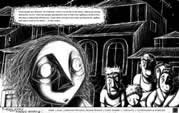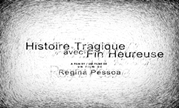Cinesheet O Clandestino
Stowaway, by Abi Feijó
Description
There is nothing more dismal than a decaying seaport, especially at night and in hard times. Such is the setting for Stowaway, Abi Feijó’s hauntingly moody animation film adapted from a story by the Portuguese writer José Rodrigues Miguéis.
On a cold, dreary Christmas Eve, a tired old freighter puts into port. Deep in its hold, a stowaway is hiding. The crew members leave the ship and go their separate ways to join their families or find other Christmas companions. After nightfall, the stowaway tries to reach dry land by sliding down a rope, but between the man, who can neither climb nor swim, and his freedom, stands an agonizing trial by fear. Far from these ochre, sunless skies, in a place where rusty-hulled ships never go, a new day may finally be dawning.
Adding to the poignancy of the tale, Abi Feijó enters the mind of the stowaway, presenting striking images that make us feel his fear. By manipulating sand on underlit superimposed glass plates, the director composes richly textured tableaux that evoke, with undeniable poetry, the dense and melancholy atmosphere of foggy seaports.
Catch phrase
Freedom calls
Videojacket
On a cold and dreary Christmas Eve, in a gloomy fogbound seaport, docks a tired old freighter. Deep in its hold, a stowaway is hiding. The crew members leave the ship and go their separate ways. After nightfall, the stowaway tries to make it to dry land by sliding down a rope, but he is paralysed with fear. Using sand animation on underlit glass plates, Stowaway is adapted from a story by the Portuguese writer José Rodrigues Miguéis. Profoundly melancholy in its expressive and richly textured imagery, the film is about one man's agonizing struggle for freedom.
Two-line summary
On a cold Christmas Eve, a freighter pulls into port. But before he can make it to dry land and freedom, a stowaway must overcome the obstacle of his own fears.






